1 YAWA (YAVA) This language is also called Yapanani ... - PapuaWeb
1 YAWA (YAVA) This language is also called Yapanani ... - PapuaWeb
1 YAWA (YAVA) This language is also called Yapanani ... - PapuaWeb
You also want an ePaper? Increase the reach of your titles
YUMPU automatically turns print PDFs into web optimized ePapers that Google loves.
<strong>YAWA</strong><br />
(<strong>YAVA</strong>)<br />
<strong>Th<strong>is</strong></strong> <strong>language</strong> <strong>is</strong> <strong>also</strong> <strong>called</strong> <strong>Yapanani</strong>, or Mora. It <strong>is</strong><br />
spoken in the northern coastal villages of Ariobu, Rosbori,<br />
Artanen, Dore, Tindaret, Kiriow, Sambarawai and Yobi; in the<br />
interior in Ambaidiru and Mambon, and on, or near, the South<br />
coast in Ariepi, Tatui, Abukarei, Aromarea, Sarawandori,<br />
Mariadei, Mantembu, Tarau, Kampong Baru, Woru, Turu, Kabuaena,<br />
<strong>Yapanani</strong>-Borai, Konti-Unai, Kainui, Wadapi-Darat (Wadapi II) and<br />
Saweru.<br />
As I mentioned before, Serui-Laut speakers are found in<br />
Aromarea and Ariepi, and Biak speakers in Sambarawai and Yobi.<br />
The town of Serui <strong>is</strong> a remarkable enclave in th<strong>is</strong> area, for it<br />
has a most / heterogeneous population which speaks mainly Dutch<br />
and Malay. The Yava <strong>language</strong> <strong>is</strong> spoken on the outskirts, that<br />
<strong>is</strong>, in Tarau, Kampong-Baru and Woru.<br />
- Anceaux 1961:8-9.<br />
The Yava lingu<strong>is</strong>tic area, with more than 4500 speakers, <strong>is</strong><br />
not homogeneous, and can be divided into a number of dialects.<br />
These have rather fluid dividing lines, a common feature in<br />
contiguous dialect areas. The dialects of Abaidiru and Mambon,<br />
Turu, Tarau, Ariepi, Woru and Kampong-Baru, Mantembu, Mariadei,<br />
Kainui and Konti Unai, Wadapi Darat, Saweru, were examined more<br />
closely than the others. It was noted that a dialect which has<br />
much in common with that of Ambaidiru, <strong>is</strong> spoken in the northern<br />
coastal villages, with the exceptions of Yobi and Sambarawai,<br />
where another dialect <strong>is</strong> spoken, and of Ariobu, whose dialect <strong>is</strong><br />
different again from the other two. Another d<strong>is</strong>tinctive dialect<br />
<strong>is</strong> spoken in Sarawandori, <strong>Yapanani</strong>-Borai and Kabuaena.<br />
Of the dialects to which special attention was paid, that of<br />
Saweru (more than 350 speakers), <strong>is</strong> the most d<strong>is</strong>tinctive, so much<br />
so, that there <strong>is</strong> a temptation to call it a separate <strong>language</strong>.<br />
But it appears that the speakers of the Saweru dialect understand<br />
the other dialects reasonably well and that on both sides there<br />
<strong>is</strong> the feeling that they speak the same <strong>language</strong>. It <strong>is</strong><br />
preferable, therefore, to call it a divergent dialect. The<br />
causes of th<strong>is</strong> divergence are probably the very <strong>is</strong>olated position<br />
of Saweru, as the only Yava speaking village situated on an<br />
<strong>is</strong>land, and its close contacts with the Ambai speakers, whose<br />
<strong>language</strong> has clearly influenced the Saweru dialect. If th<strong>is</strong> <strong>is</strong><br />
indeed so, the Saweru dialect will in the future probaly diverge<br />
so much from the other Yava dialects, that it will no longer be<br />
possible to deny it the status of a separate <strong>language</strong>.<br />
The very d<strong>is</strong>tinctive character of the dialect spoken in a<br />
few Mora villages in the interior, in Ambaidiru and Mambon,<br />
should <strong>also</strong> be attributed to their <strong>is</strong>olation. The dialect of<br />
Wadapi-Darat and that of Kontu-Unai and Kainui are less d<strong>is</strong>tinct;<br />
although they show a large number of d<strong>is</strong>tinctive character<strong>is</strong>tics,<br />
they have considerable features in common. The dialect of Ariepi<br />
1
stands somewhat apart from the others. The group of Mariadei,<br />
Kampong Baru, Mantembu, Tarau and Turu dialects <strong>is</strong> fairly<br />
homogeneous; the dialects of Kampong-Baru and Woru and that of<br />
Turu show most similarities, while that of Mariadei <strong>is</strong> the most<br />
divergent of th<strong>is</strong> group.<br />
- Anceaux 1961:9.<br />
*<br />
The Yava <strong>language</strong>, locally <strong>also</strong> known as <strong>Yapanani</strong> or Mora,<br />
<strong>is</strong> spoken in the middle section of Yapen <strong>is</strong>land; in the west and<br />
east it borders on Austronesian <strong>language</strong>s, which take up the<br />
remainder of the <strong>is</strong>land. ... Yava <strong>is</strong> spoken by more than 4,500<br />
people; there are 15 dialects, some of them spoken in one village<br />
only.<br />
- Voorhoeve 1975d:873.<br />
4500 + [speakers]<br />
Dialects: There are fifteen dialects, spoken in the<br />
following villages:<br />
1. in Ariobu, Rasbori, Artanen, Dore, Tindaret, Kiriow;<br />
2. in Sambarawai, Yobi;<br />
3. in Ambaidiru, Mombon;<br />
4. in Ariepi;<br />
5. in Tatui, Abukarei, Aromarea;<br />
6. in Sarawandori;<br />
7. in Mariadei;<br />
8. in Mantembu;<br />
9. in Taraum Kampong Baru, Woru;<br />
10. in Tutu;<br />
11. in Kabuaena;<br />
12. in <strong>Yapanani</strong>-Borai;<br />
13. in Konti-Unai, Kainui;<br />
14. in Wadapi Darat;<br />
15. in Saweru.<br />
- Voorhoeve 1975f:50.<br />
*<br />
[Map]<br />
Serui -- <strong>YAVA</strong><br />
Mambon -- <strong>YAVA</strong><br />
Ariobu -- <strong>YAVA</strong><br />
Kiriow -- <strong>YAVA</strong><br />
Yobi -- <strong>YAVA</strong><br />
- Wurm & Hattori 1981<br />
(<strong>YAWA</strong>)<br />
Yawa (Mantembu; Mora; <strong>Yapanani</strong>; Turu 2)<br />
POP: +/- 6,000<br />
LOC: Central Yapen <strong>is</strong>land<br />
*<br />
2
- Silzer & Heikkinen 1984:103.<br />
(<strong>YAWA</strong>)<br />
(Mantembu; Mora; <strong>Yapanani</strong>; Turu 2)<br />
6,000<br />
LOC: Central Yapen Island<br />
- Silzer & Clouse 1991:87.<br />
*<br />
Relatively little has been written and publ<strong>is</strong>hed about the<br />
non-Austronesian <strong>language</strong> spoken on Yapen Island, which <strong>is</strong><br />
located in Cenderawasih (formerly Geelvink) Bay, Irian Jaya,<br />
Indonesia. Anceaux (1961:8-11), calling the <strong>language</strong> Yava, ...<br />
Voorhoeve (1975:873-876), basing h<strong>is</strong> analys<strong>is</strong> on Anceaux's<br />
unpubl<strong>is</strong>hed word l<strong>is</strong>ts, classified Yava as part of the Geelvink<br />
Bay Phylum, with d<strong>is</strong>tant relationships to the non-Austronesian<br />
<strong>language</strong>s spoken in the interior of northern Irian Jaya. A few<br />
grammatical notes on th<strong>is</strong> <strong>language</strong>, under the name Mantembu,<br />
appears in Cowan 1953. A word l<strong>is</strong>t, under the name Turu, was<br />
publ<strong>is</strong>hed in Gal<strong>is</strong> 1955. In th<strong>is</strong> paper, the name Yawa will be<br />
used to refer to the entire non-Austronesian <strong>language</strong> group on<br />
Yapen. ...<br />
- L.B. Jones 1986:31.<br />
Yawa <strong>is</strong> spoken by approximately 6000 people living in the<br />
central part of Yapen Island. There are Yawa villages on both<br />
the north and south coasts of Yapen, and a few villages in the<br />
mountainous interor of the <strong>is</strong>land as well. The major Yawa<br />
villages on or near the south coast are, from west to east,<br />
Ariepi, Tatui, Aromarea, Sarawandori, Mariadei, Mantembu,<br />
Anotaurei, Turu, Kabuena, <strong>Yapanani</strong>, Konti-unai, Kainui, and<br />
Wadapi Darat. The Yawa villages on or near the north coast are,<br />
from west to east, Ariobu, Rosbori, Artanen, Dore, Tindaret,<br />
Kiriow, and Sambarawai. The villages in the mountainous interior<br />
which speak Yawa are Ambaidiru and Mambon. The above l<strong>is</strong>t does<br />
not include several small hamlets of one or two houses, nor does<br />
it include villages l<strong>is</strong>ted in Anceaux 1961 which have since been<br />
absorbed by the growing township of Serui and thus lost their<br />
d<strong>is</strong>tinctive Yawa character and their use of the Yawa <strong>language</strong>.<br />
Further, the <strong>language</strong> spoken on the <strong>is</strong>land of Saweru, off the<br />
south coast of Yapen, has been omitted from th<strong>is</strong> study. Anceaux<br />
(1961) and Voorhoeve (1975) included th<strong>is</strong> <strong>language</strong> in their<br />
d<strong>is</strong>cussions of Yawa on the bas<strong>is</strong> of its obvious h<strong>is</strong>torical<br />
connection to the main Yawa dialects. However, it has diverged<br />
so much from the other Yawa dialects and has borrowed so heavily<br />
from neighbouring Austronesian <strong>language</strong>s that it <strong>is</strong> now<br />
unintelligible to Yawa speakers from Yapen proper, and <strong>is</strong><br />
perceived by them as a totally separate <strong>language</strong>. As such Saweru<br />
was judged to require separate, more complete treatment in a<br />
future study.<br />
3
- L.B. Jones 1986:31.<br />
... In th<strong>is</strong> study 15 groups of Yawa speakers from all parts of<br />
the Yawa <strong>language</strong> area were presented with a l<strong>is</strong>t of all major<br />
Yawa villages and asked to classify the villages according to<br />
which villages spoke exactly the same ... as which other<br />
villages. <strong>Th<strong>is</strong></strong> type of direct questioning did not yield entirely<br />
cons<strong>is</strong>tent resuts. ...<br />
The significant data stemming from th<strong>is</strong> survey of native<br />
speaker intuitions regarding dialect boundaries came in answer to<br />
the question, 'Which villages speak exactly the same as your home<br />
village?' There was striking, 100 per cent cons<strong>is</strong>tency in<br />
informant answers to th<strong>is</strong> question. All informants from the same<br />
village gave identical answers to the question. More<br />
significantly, all the villages of a given dialect grouping were<br />
in unanimous agreement as to the membership of that grouping. ...<br />
These informant intuitions defined five major dialect<br />
groupings in the Yawa <strong>language</strong> area: a central dialect, composed<br />
of the villages of Ambaidiru and Mambon in the mountains, Ariobu,<br />
Rosbori, and Artanen on the north coast, and Ariepi on the south<br />
coast; a northern dialect, composed of the villages of Kontiunai,<br />
<strong>Yapanani</strong>, Wadapi Darat and Kainui, on or near the south<br />
coast, and Sambarawai on the north coast; a southern dialect<br />
composed of the villages of Turu, Mariadei, Anotaurei, Kabuena,<br />
and a few clusters of Yaswa speakers now living in the township<br />
of Serui; and a western dialect, composed of the villages of<br />
Sarawandori, Aromarea, and Tatui on the south coast, and<br />
Mantembu, inland from Serui. With one exception (the position of<br />
Ariepi) ..., these dialect groupings were confirmed by the<br />
lexical and intelligibility test analyses reported in th<strong>is</strong> study.<br />
- L.B. Jones 1986:32.<br />
Anceaux notes that the single non-Austronesian <strong>language</strong> on<br />
Yapen Island <strong>is</strong> referred to variously as Yava, <strong>Yapanani</strong>, and<br />
Mora. The latter two names, in fact, refer to the dialects<br />
spoken by two large clans located on the south coast (<strong>Yapanani</strong>)<br />
and in the interior (Mora). There <strong>is</strong> no one name that all the<br />
speakers will agree upon for the name of their <strong>language</strong>, most<br />
speakers preferring a name that <strong>is</strong> suitable only for their<br />
particular dialect, since it <strong>is</strong> the name of their ancestor.<br />
Others use an expression meaning 'the land <strong>language</strong>', referring<br />
to the non-Austronesians as a group ('the land people') d<strong>is</strong>tinct<br />
from the Austronesians ('the sea people'). While there are a<br />
number of dialects, it <strong>is</strong> nonetheless clear that they compr<strong>is</strong>e a<br />
single <strong>language</strong>. ...<br />
- L.K. Jones 1986:27, n. 4.<br />
The Yawa <strong>language</strong> <strong>is</strong> a Papuan <strong>language</strong> and has been<br />
classified as a stock-level <strong>is</strong>olate in the Geelvink Bay Phylum, a<br />
minor phylum restricted to a small section of the north coast of<br />
Irian Jaya ... It <strong>is</strong> spoken by approximately 6000 speakers in<br />
4
more than two dozen villages throughout central Yapen Island.<br />
There are a number of dialects ...<br />
- L.K. Jones 1991:104, n. 1.<br />
The Yawa people, numbering about 6000, occupy the center of<br />
Yapen, a long mountainous <strong>is</strong>land off the north coast of Irian<br />
Jaya, Indonesia ... Orignally they resided mostly in tiny hamlets<br />
in the interior of the <strong>is</strong>land, but at the behest of the<br />
government during the Dutch admin<strong>is</strong>tration in the early decades<br />
of th<strong>is</strong> centruy, they were gathered in villages, most of which<br />
are located along either the north coast or the south coast of<br />
the <strong>is</strong>land, but with one very large village and one smaller one<br />
in the interior. ...<br />
- L.K. Jones 1997:52.<br />
[Map]<br />
Amdairiu<br />
Anotaurei<br />
Ariepi<br />
Ariobu<br />
Aromarea<br />
Artanen<br />
Dore<br />
Kabuena<br />
Kainui<br />
Kiriow<br />
Konti-Unai<br />
Mambon<br />
Mantembu<br />
Mariadei<br />
Rosbori<br />
Sambarawai<br />
Sarawandori<br />
Saweru I<br />
Serui<br />
Tatui<br />
Tindaret<br />
Turu<br />
Wadapi<br />
<strong>Yapanani</strong><br />
- L.K. Jones 1997:53.<br />
*<br />
Yawa: 6,000 speakers reported in 1987, on central Yapen<br />
Island, Cenderawasih Bay. Also <strong>called</strong> <strong>Yapanani</strong>, Mora, Turu,<br />
Mantembu, Yava, or Iau. Close to Bauzi and east Geelvink Bay<br />
<strong>language</strong>s. D<strong>is</strong>tinct from Iau in the Lakes Plain area.<br />
- Comrie 1992l:41.<br />
*<br />
5
Central Yapen Island, Yapen Waropen, Yapen Selatan, Timur,<br />
Barat, 8 north coast villages, 2 interior villages, 18 south<br />
coast villages. ... Dialects: CENTRAL <strong>YAWA</strong> (MORA), WEST <strong>YAWA</strong>,<br />
SOUTH <strong>YAWA</strong>, NORTH <strong>YAWA</strong>, EAST <strong>YAWA</strong>. Close to Bauzi and East<br />
Geelvink Bay <strong>language</strong>s. D<strong>is</strong>trict from Iau in Lakes Plain area.<br />
...<br />
- Grimes 1992:585.<br />
<strong>YAWA</strong> (YAPANANI, MORA, TURU, MANTEMBU, <strong>YAVA</strong>, IAU) ... 6,000<br />
(1987 SIL). Central Serui Island, Serui Waropen, Serui Selatan,<br />
Timur Barat, 8 north coast villages, 2 interior villages, 18<br />
south coast villages. ... Dialects: CENTRAL <strong>YAWA</strong> (MORA), WEST<br />
<strong>YAWA</strong>, SOUTH <strong>YAWA</strong>, NORTH <strong>YAWA</strong>, EAST <strong>YAWA</strong>. D<strong>is</strong>tinct from Iau in<br />
Lakes Plain area. ...<br />
- Grimes 1996.<br />
<strong>YAWA</strong> (YAPANANI, MORA, TURU, MANTEMBU, <strong>YAVA</strong>, IAU) ... 6,000<br />
(1987 SIL). Central Serui Island, Serui Waropen, Serui Selatan,<br />
Timur Barat, 8 north coast villages, 2 interior villages, 18<br />
south coast villages. Lingu<strong>is</strong>tic affiliation: Geelvink Bay, Yawa.<br />
Dialects: CENTRAL <strong>YAWA</strong> (MORA), WEST <strong>YAWA</strong>, SOUTH <strong>YAWA</strong>, NORTH <strong>YAWA</strong>,<br />
EAST <strong>YAWA</strong>. D<strong>is</strong>tinct from Iau in Lakes Plain area. ...<br />
- Grimes 2000.<br />
*<br />
... Yawa ... <strong>is</strong> the larger <strong>language</strong>, spoken on mainland Yapen<br />
<strong>is</strong>land by approximately / 6,000 people. ... Yawa and Saweru have<br />
not been demonstrated to be related to any other <strong>language</strong>s on<br />
mainland New Guinea, ...<br />
- Donohue 2001b:296-297.<br />
*<br />
(Turu of Mora)<br />
Mantembu, Serui-darat, Mariadei, Sarawendori, Aromarea,<br />
Tatui, Konti, Abukarei (Samber), Unai, Manarei, Ambeidiru,<br />
Ariëpi, Tindarei, Permuari (Ambopei), Ariobu, Wadapi (Binti),<br />
Kiriau, Saweru, Dore, Mansa, Artaneng (+ 3300 zielen).<br />
- Gal<strong>is</strong> 1955-56:172.<br />
*<br />
... Progressing from the west to the east along the south coast<br />
of Yapen, we note the following Ambai-speaking villages ...<br />
Menawi/Borai ..., Wadapi Laut ..., Randawaya I (Warironi)<br />
..., Randawaya II ..., Sumberbaba (A<strong>is</strong>umbewawafi) ..., and Dawai<br />
... Of these villages Wadapi Laut <strong>also</strong> contains Mora speakers (a<br />
Non-Austronesian <strong>language</strong>) and Dawai contains Wabo speakers (an<br />
AN <strong>language</strong> in the two-member Eastern Yapen subgroup). ...<br />
- Silzer 1983:2.<br />
* * *<br />
6
<strong>YAVA</strong> 4,500+ Anceaux 1961, Voorhoeve<br />
<strong>YAVA</strong> 8,000 ISO (Wurm & Hattori 1981,<br />
Wurm 1982)<br />
<strong>YAVA</strong> = <strong>YAWA</strong> Jones 1986; Comrie 1992l; Grimes<br />
<strong>YAVA</strong> 6,000 s-level ISO (Wurm 1994)<br />
<strong>YAWA</strong> 6,000 ISO (Silzer & Heikkinen<br />
<strong>YAWA</strong> 6,000 Jones 1986, 1991, 1997<br />
<strong>YAWA</strong> 6,000 (1987) Geelvink Bay (Comrie<br />
1992l)<br />
<strong>YAWA</strong> Smits & Voorhoeve 1998<br />
<strong>YAWA</strong> 6,000 Yawa (Grimes 2000,<br />
IAU = <strong>YAWA</strong> Comrie 1992l Grimes 1992, 1996,<br />
YAPANANI = <strong>YAVA</strong> Anceaux 1961; Voorhoeve 1975; Wurm<br />
& Hattori 1981; Wurm 1982, 1994<br />
YAPANANI = <strong>YAWA</strong> Silzer & Heikkinen 1984; Silzer &<br />
YAPANANI -- d of <strong>YAWA</strong> Jones 1986<br />
YAPANANI-BORAI -- d of <strong>YAVA</strong> Anceaux 1961, Voorhoeve 1975, Wurm<br />
& Hattori 1981, Wurm 1982<br />
JAPEN, MIDDEN Cowan 1953<br />
YAPEN, ORIGINAL = ? <strong>YAWA</strong> Capell 1954 (cf S&C)<br />
MANTEMBU = MIDDEN-JAPEN Cowan 1953<br />
MANTEMBU Capell 1962 (Cowan), Wurm 1971<br />
MANTEMBU = <strong>YAVA</strong> Wurm & Hattori 1981; Wurm 1982,<br />
MANTEMBU = <strong>YAWA</strong> Silzer & Heikkinen 1984; Jones<br />
MANTEMBU -- d of <strong>YAVA</strong> Anceaux 1961, Voorhoeve 1975, Wurm<br />
& Hattori 1981, Wurm 1982<br />
MORA = TURU (2) Gal<strong>is</strong> 1955-56<br />
MORA = <strong>YAVA</strong> Anceaux 1961; Voorhoeve 1975; Wurm<br />
& Hattori 1981; Wurm 1982, 1994<br />
MORA = <strong>YAWA</strong> Silzer & Heikkinen 1984; Silzer &<br />
MORA = CENTRAL <strong>YAWA</strong> d of<br />
<strong>YAWA</strong> Grimes 1992, 1996, 2000<br />
MORA -- d of <strong>YAWA</strong> Jones 1986<br />
TURU (2) 3,300 Gal<strong>is</strong> 1955-56<br />
TURU (2) = <strong>YAVA</strong> Wurm & Hattori 1981, Wurm 1982<br />
TURU (2) = <strong>YAWA</strong> Silzer & Heikkinen 1984; Jones<br />
TURU -- d of <strong>YAVA</strong> Anceaux 1961, Wurm 1982<br />
TUTU -- d of <strong>YAVA</strong> Voorhoeve 1975, Wurm & Hattori 1981<br />
Abukarei -- TURU (2) Gal<strong>is</strong> 1955-56<br />
Abukarei -- <strong>YAVA</strong> Anecaux 1961, Voorhoeve 1975<br />
ABAIDIRU -- d of <strong>YAVA</strong> Anceaux 1961, Voorhoeve 1975<br />
7
Ambaidiru -- <strong>YAVA</strong> Anceaux 1961, Voorhoeve 1975<br />
Ambaidiru -- <strong>YAWA</strong> Jones 1986, Silzer & Clouse 1991,<br />
Ambeidiru -- TURU (2) Gal<strong>is</strong> 1955-56<br />
Amdairiu -- <strong>YAWA</strong> L.K. Jones 1997<br />
Ambopei = Permuari -- TURU<br />
(2) Gal<strong>is</strong> 1955-56<br />
Anotaurei -- <strong>YAWA</strong> Jones 1986, 1997<br />
ARIEPI -- d of <strong>YAVA</strong> Anceaux 1961, Voorhoeve 1975, Wurm<br />
& Hattori 1981, Wurm 1982<br />
Ariëpi -- TURU (2) Gal<strong>is</strong> 1955-56<br />
Ariepi -- <strong>YAVA</strong> Anceaux 1961, Voorhoeve 1975<br />
Ariepi -- <strong>YAWA</strong> Jones 1986, 1997; Smits & Voorhoeve<br />
1998<br />
ARIOBU et al -- d of <strong>YAVA</strong> Voorhoeve 1975<br />
Ariobu -- TURU (2) Gal<strong>is</strong> 1955-56<br />
Ariobu -- <strong>YAVA</strong> Anceaux 1961, Voorhoeve 1975, Wurm<br />
& Hattori 1981<br />
Ariobu -- <strong>YAWA</strong> Jones 1986, 1997<br />
Aromarea -- TURU (2) Gal<strong>is</strong> 1955-56<br />
Aromarea -- <strong>YAVA</strong> Anceaux 1961, Voorhoeve 1975<br />
Aromarea -- <strong>YAWA</strong> Jones 1986, 1997<br />
Artanen -- <strong>YAVA</strong> Anceaux 1961, Voorhoeve 1975<br />
Artanen -- <strong>YAWA</strong> Jones 1986, 1997<br />
Artaneng -- TURU (2) Gal<strong>is</strong> 1955-56<br />
Binti = Wadapi -- TURU (2) Gal<strong>is</strong> 1955-56<br />
Dore -- TURU (2) Gal<strong>is</strong> 1955-56<br />
Dore -- <strong>YAVA</strong> Anceaux 1961, Voorhoeve 1975<br />
Dore -- <strong>YAWA</strong> Jones 1986, 1997<br />
<strong>Yapanani</strong> -- <strong>YAWA</strong> Jones 1986, 1997<br />
<strong>Yapanani</strong>-Borai -- <strong>YAVA</strong> Anceaux 1961, Voorhoeve 1975<br />
Yobi -- <strong>YAVA</strong> Anceaux 1961, Voorhoeve 1975, Wurm<br />
& Hattori 1981<br />
KABUAENA -- d of <strong>YAVA</strong> Anceaux 1961, Voorhoeve 1975, Wurm<br />
& Hattori 1981, Wurm 1982<br />
Kabuaena -- <strong>YAVA</strong> Anceaux 1961, Voorhoeve 1975<br />
Kabuena -- <strong>YAWA</strong> Jones 1986, 1997<br />
8
KAINUI -- d of <strong>YAVA</strong> Anceaux 1961<br />
Kainui -- <strong>YAVA</strong> Anceaux 1961, Voorhoeve 1975<br />
Kainui -- <strong>YAWA</strong> Jones 1986, 1997<br />
KAMPONG BARU -- d of <strong>YAVA</strong> Anceaux 1961<br />
Kampong Baru -- <strong>YAVA</strong> Anceaux 1961<br />
Kampung Baru -- <strong>YAWA</strong> Smits & Voorhoeve 1998<br />
Kiriau -- TURU (2) Gal<strong>is</strong> 1955-56<br />
Kiriow -- <strong>YAVA</strong> Anceaux 1961, Voorhoeve 1975, Wurm<br />
& Hattori 1981<br />
Kiriow -- <strong>YAWA</strong> Jones 1986, 1997<br />
KONTI UNAI -- d of <strong>YAVA</strong> Anceaux 1961, Voorhoeve 1975, Wurm<br />
& Hattori 1981, Wurm 1982<br />
Konti -- TURU (2) Gal<strong>is</strong> 1955-56<br />
Konti-Unai -- <strong>YAVA</strong> Anceaux 1961, Voorhoeve 1975<br />
Konti-Unai -- <strong>YAWA</strong> Jones 1986, 1997; Smits & Voorhoeve<br />
1998<br />
MAMBON -- d of <strong>YAVA</strong> Anceaux 1961<br />
Mambon -- <strong>YAVA</strong> Anceaux 1961, Wurm & Hattori 1981<br />
Mambon -- <strong>YAWA</strong> Jones 1986, 1997<br />
Mombon -- <strong>YAVA</strong> Voorhoeve 1975<br />
Manarei -- TURU (2) Gal<strong>is</strong> 1955-56<br />
Mansa -- TURU (2) Gal<strong>is</strong> 1955-56<br />
Mantembu -- TURU (2) Gal<strong>is</strong> 1955-56<br />
Mantembu -- <strong>YAVA</strong> Anceaux 1961, Voorhoeve 1975<br />
Mantembu -- <strong>YAWA</strong> Jones 1986, 1997; Smits & Voorhoeve<br />
1998<br />
MARIADEI -- d of <strong>YAVA</strong> Anceaux 1961, Voorhoeve 1975, Wurm<br />
& Hattori 1981, Wurm 1982<br />
Mariadei -- TURU (2) Gal<strong>is</strong> 1955-56<br />
Mariadei -- <strong>YAVA</strong> Anceaux 1961, Voorhoeve 1975<br />
Mariadei -- <strong>YAWA</strong> Jones 1986, 1997; Smits & Voorhoeve<br />
1998<br />
Menawi -- <strong>YAWA</strong> Silzer & Clouse 1991<br />
Permuari -- TURU (2) Gal<strong>is</strong> 1955-56<br />
Rasbori -- <strong>YAVA</strong> Voorhoeve 1975<br />
9
Rosbori -- <strong>YAVA</strong> Anceaux 1961<br />
Rosbori -- <strong>YAWA</strong> Jones 1986, 1997; Silzer & Clouse<br />
SAMBARAWAI -- d of <strong>YAVA</strong> Voorhoeve 1975<br />
Sambarawai -- <strong>YAVA</strong> Anceaux 1961, Voorhoeve 1975<br />
Sambarawai -- <strong>YAWA</strong> Jones 1986, 1997<br />
Samber = Abukarei -- TURU (2) Gal<strong>is</strong> 1955-56<br />
SARAWANDORI -- d of <strong>YAVA</strong> Anceaux 1961, Voorhoeve 1975, Wurm<br />
& Hattori 1981, Wurm 1982<br />
Sarawandori -- <strong>YAVA</strong> Anceaux 1961, Voorhoeve 1975<br />
Sarawandori -- <strong>YAWA</strong> Jones 1986, 1997<br />
Sarawendori -- TURU (2) Gal<strong>is</strong> 1955-56<br />
Serui -- <strong>YAVA</strong> Wurm & Hattori 1981<br />
Serui -- <strong>YAWA</strong> L.K. Jones 1997<br />
Soeroei -- <strong>YAWA</strong> de Clercq & Schmeltz 1893 (cf S&C)<br />
Serui-darat -- TURU (2) Gal<strong>is</strong> 1955-56<br />
TARAU -- d of <strong>YAVA</strong> Anceaux 1961, Wurm & Hattori 1981,<br />
Wurm 1982<br />
TARAUM KAMPONG BARU -- d of<br />
<strong>YAVA</strong> Voorhoeve 1975<br />
Tarau -- <strong>YAVA</strong> Anceaux 1961<br />
Tarau -- <strong>YAWA</strong> Smits & Voorhoeve 1998<br />
Taraum Kampong Baru -- <strong>YAVA</strong> Voorhoeve 1975<br />
TATUI -- d of <strong>YAVA</strong> Voorhoeve 1975, Wurm & Hattori<br />
Tatui -- TURU (2) Gal<strong>is</strong> 1955-56<br />
Tatui -- <strong>YAVA</strong> Anceaux 1961, Voorhoeve 1975<br />
Tatui -- <strong>YAWA</strong> Jones 1986, 1997<br />
Tindarei -- TURU (2) Gal<strong>is</strong> 1955-56<br />
Tindaret -- <strong>YAVA</strong> Anceaux 1961, Voorhoeve 1975<br />
Tindaret -- <strong>YAWA</strong> Jones 1986, 1997<br />
Turu -- <strong>YAVA</strong> Anceaux 1961<br />
Turu -- <strong>YAWA</strong> Jones 1986, 1997; Smits & Voorhoeve<br />
1998<br />
Tutu -- <strong>YAVA</strong> Voorhoeve 1975<br />
Unai -- TURU (2) Gal<strong>is</strong> 1955-56<br />
WADAPI DARAT -- d of <strong>YAVA</strong> Anceaux 1961, Voorhoeve 1975, Wurm<br />
& Hattori 1981, Wurm 1982<br />
10
Wadapi -- TURU (2) Gal<strong>is</strong> 1955-56<br />
Wadapi Darat (Wadapi II) --<br />
<strong>YAVA</strong> Anceaux 1961, Voorhoeve 1975<br />
Wadapi Darat -- <strong>YAWA</strong> Jones 1986, Smits & Voorhoeve 1998<br />
Wadapi -- <strong>YAWA</strong> L.K. Jones 1997<br />
Wadapi Laut -- AMBAI/MORA Silzer 1983<br />
WORU -- d of <strong>YAVA</strong> Anceaux 1961<br />
Woru -- <strong>YAVA</strong> Anceaux 1961, Voorhoeve 1975<br />
* * * * *<br />
11



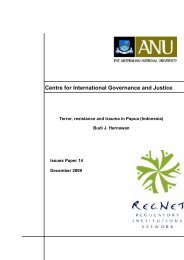
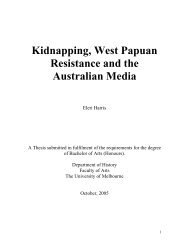
![[1958: Gahuku]. - PapuaWeb](https://img.yumpu.com/25139694/1/190x245/1958-gahuku-papuaweb.jpg?quality=85)
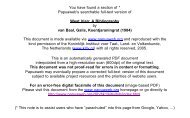


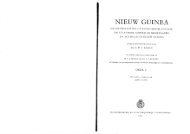
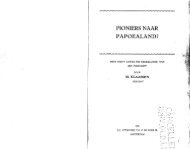
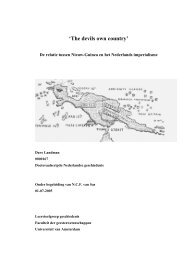
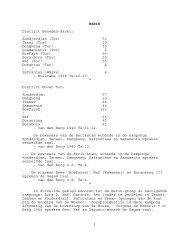
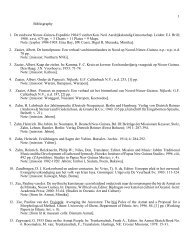

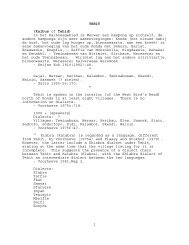
![1 EKARI (EKAGI) [Map] (cf S&C) Akaromani Apoejai ... - PapuaWeb](https://img.yumpu.com/19731685/1/190x245/1-ekari-ekagi-map-cf-sc-akaromani-apoejai-papuaweb.jpg?quality=85)
![WUTUNG [passim in text] Wutung (Oenaki, Oinåke) - Friederici ...](https://img.yumpu.com/15960045/1/190x245/wutung-passim-in-text-wutung-oenaki-oinake-friederici-.jpg?quality=85)